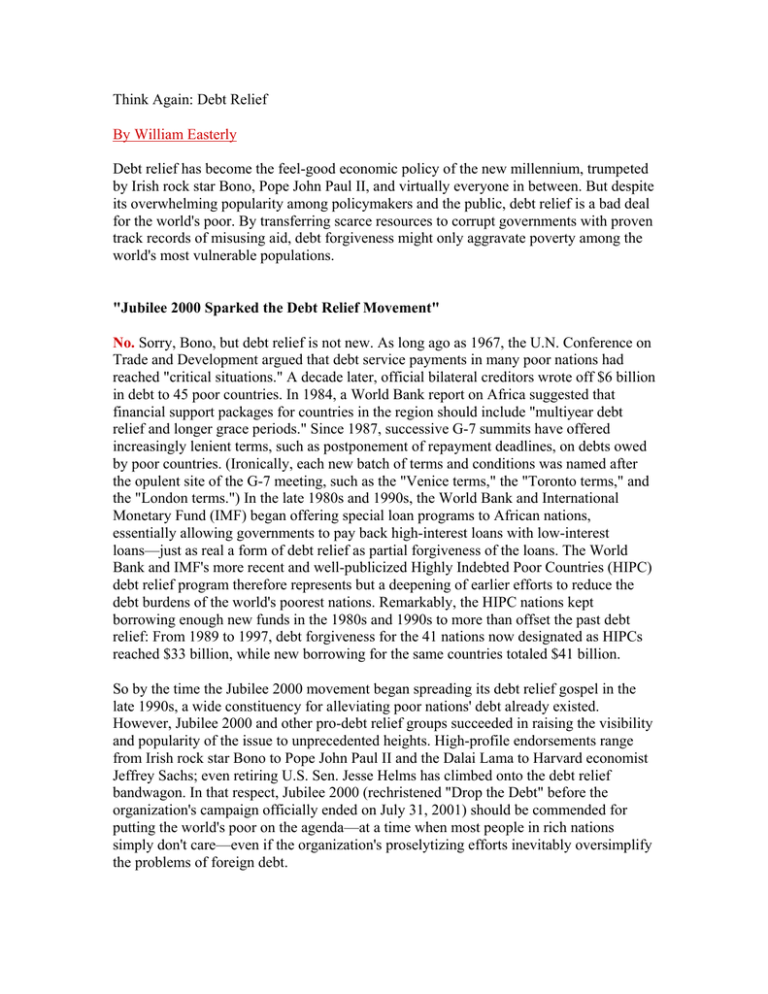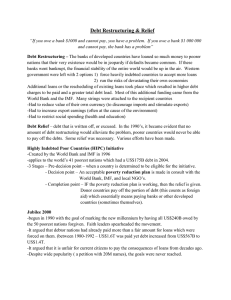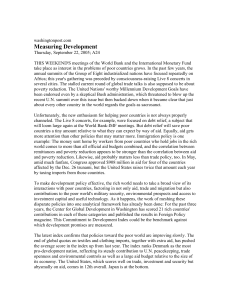Think Again: Debt Relief By William Easterly
advertisement

Think Again: Debt Relief By William Easterly Debt relief has become the feel-good economic policy of the new millennium, trumpeted by Irish rock star Bono, Pope John Paul II, and virtually everyone in between. But despite its overwhelming popularity among policymakers and the public, debt relief is a bad deal for the world's poor. By transferring scarce resources to corrupt governments with proven track records of misusing aid, debt forgiveness might only aggravate poverty among the world's most vulnerable populations. "Jubilee 2000 Sparked the Debt Relief Movement" No. Sorry, Bono, but debt relief is not new. As long ago as 1967, the U.N. Conference on Trade and Development argued that debt service payments in many poor nations had reached "critical situations." A decade later, official bilateral creditors wrote off $6 billion in debt to 45 poor countries. In 1984, a World Bank report on Africa suggested that financial support packages for countries in the region should include "multiyear debt relief and longer grace periods." Since 1987, successive G-7 summits have offered increasingly lenient terms, such as postponement of repayment deadlines, on debts owed by poor countries. (Ironically, each new batch of terms and conditions was named after the opulent site of the G-7 meeting, such as the "Venice terms," the "Toronto terms," and the "London terms.") In the late 1980s and 1990s, the World Bank and International Monetary Fund (IMF) began offering special loan programs to African nations, essentially allowing governments to pay back high-interest loans with low-interest loans—just as real a form of debt relief as partial forgiveness of the loans. The World Bank and IMF's more recent and well-publicized Highly Indebted Poor Countries (HIPC) debt relief program therefore represents but a deepening of earlier efforts to reduce the debt burdens of the world's poorest nations. Remarkably, the HIPC nations kept borrowing enough new funds in the 1980s and 1990s to more than offset the past debt relief: From 1989 to 1997, debt forgiveness for the 41 nations now designated as HIPCs reached $33 billion, while new borrowing for the same countries totaled $41 billion. So by the time the Jubilee 2000 movement began spreading its debt relief gospel in the late 1990s, a wide constituency for alleviating poor nations' debt already existed. However, Jubilee 2000 and other pro-debt relief groups succeeded in raising the visibility and popularity of the issue to unprecedented heights. High-profile endorsements range from Irish rock star Bono to Pope John Paul II and the Dalai Lama to Harvard economist Jeffrey Sachs; even retiring U.S. Sen. Jesse Helms has climbed onto the debt relief bandwagon. In that respect, Jubilee 2000 (rechristened "Drop the Debt" before the organization's campaign officially ended on July 31, 2001) should be commended for putting the world's poor on the agenda—at a time when most people in rich nations simply don't care—even if the organization's proselytizing efforts inevitably oversimplify the problems of foreign debt. "Third World Debts Are Illegitimate" Unhelpful idea. Supporters of debt relief programs have often argued that new democratic governments in poor nations should not be forced to honor the debts that were incurred and mismanaged long ago by their corrupt and dictatorial predecessors. Certainly, some justice would be served if a legitimate and reformist new government refused to repay creditors foolish enough to have lent to a rotten old autocracy. But, in reality, there are few clear-cut political breaks with a corrupt past. The political factors that make governments corrupt tend to persist over time. How "clean" must the new government be to represent a complete departure from the misdeeds of an earlier regime? Consider President Yoweri Museveni of Uganda, about the strongest possible example of a change from the past—in his case, the notorious past of Ugandan strongman Idi Amin. Yet even Museveni's government continues to spend money on questionable military adventures in the Democratic Republic of the Congo. Would Museveni qualify for debt relief under the "good new government" principle? And suppose a long-time corrupt politician remains in power, such as Kenyan President Daniel Arap Moi. True justice would instead call for such leaders to pay back some of their loot to development agencies, who could then lend the money to a government with cleaner hands—a highly unlikely scenario. Making debt forgiveness contingent on the supposed "illegitimacy" of the original borrower simply creates perverse incentives by directing scarce aid resources to countries that have best proved their capacity to mismanage such funds. For example, Ivory Coast built not just one but two new national capitals in the hometowns of the country's previous rulers as it was piling up debt. Then it had a military coup and a tainted election. Is that the environment in which aid will be well used? Meanwhile, poor nations that did not mismanage their aid loans so badly—such as India and Bangladesh—now do not qualify for debt relief, even though their governments would likely put fresh aid resources to much better use. Finally, the legitimacy rationale raises serious reputation concerns in the world's financial markets. Few private lenders will wish to provide fresh financing to a country if they know that a successor government has the right to repudiate the earlier debt as illegitimate. For the legitimacy argument to be at all convincing, the countries in question must show a huge and permanent change from the corruption of past regimes. Indeed, strict application of such a standard introduces the dread specter of "conditionality," i.e., the imposition of burdensome policy requirements on developing nations in exchange for assistance from international financial institutions. Only rather than focusing solely on economic policy conditions, the international lending agencies granting debt relief would now be compelled to make increasingly subjective judgments regarding a country's politics, governance structures, and adherence to the rule of law. "Crushing Debts Worsen Third World Poverty" Wrong in more ways than one. Yes, the total long-term debt of the 41 HIPC nations grew from $47 billion in 1980 to $159 billion in 1990 to $169 billion in 1999, but in reality the foreign debt of poor countries has always been partly fictional. Whenever debt service became too onerous, the poor nations simply received new loans to repay old ones. Recent studies have found that new World Bank adjustment loans to poor countries in the 1980s and 1990s increased in lock step with mounting debt service. Likewise, another study found that official lenders tend to match increases in the payment obligations of highly indebted African countries with an increase in new loans. Indeed, over the past two decades, new lending to African countries more than covered debt service payments on old loans. Second, debt relief advocates should remember that poor people don't owe foreign debt— their governments do. Poor nations suffer poverty not because of high debt burdens but because spendthrift governments constantly seek to redistribute the existing economic pie to privileged political élites rather than try to make the pie grow larger through sound economic policies. The debt-burdened government of Kenya managed to find enough money to reward President Moi's home region with the Eldoret International Airport in 1996, a facility that almost nobody uses. Left to themselves, bad governments are likely to engage in new borrowing to replace the forgiven loans, so the debt burden wouldn't fall in the end anyway. And even if irresponsible governments do not run up new debts, they could always finance their redistributive ways by running down government assets (like oil and minerals), leaving future generations condemned to the same overall debt burden. Ultimately, debt relief will only help reduce debt burdens if government policies make a true shift away from redistributive politics and toward a focus on economic development. "Debt Relief Allows Poor Nations to Spend More on Health and Education" No. In 1999, Jubilee 2000 enthused that with debt relief "the year 2000 could signal the beginning of dramatic improvements in healthcare, education, employment and development for countries crippled by debt." Unfortunately, such statements fail to recognize some harsh realities about government spending. First, the iron law of public finance states that money is fungible: Debt relief goes into the same government account that rains money on good and bad uses alike. Debt relief enables governments to spend more on weapons, for example. Debt relief clients such as Angola, Ethiopia, and Rwanda all have heavy military spending (although some are promising to make cuts). To assess whether debt relief increases health and education spending, one must ask what such spending would have been in the absence of debt relief—a difficult question. However, if governments didn't spend the original loans on helping the poor, it's a stretch to expect them to devote new fiscal resources toward helping the poor. Second, such claims assume that the central government knows where its money is going. A recent IMF and World Bank study found that only two out of 25 debt relief recipients will have satisfactory capacity to track where government spending goes within a year. At the national level, an additional study found that only 13 percent of central government grants for nonsalary education spending in Uganda (another recipient of debt relief) actually made it to the local schools that were the intended beneficiaries. Finally, the very idea that the proceeds of debt relief should be spent on health and education contains a logical flaw. If debt relief proceeds are spent on social programs rather than used to pay down the debt, then the debt burden will remain just as crushing as it was before. A government can't use the same money twice—first to pay down foreign debt and second to expand health and education services for the poor. This magic could only work if health and education spending boosted economic growth and thus generated future tax revenues to service the debt. Unfortunately, there is little evidence that higher health and education spending is associated with faster economic growth. "Debt Relief Will Empower Poor Countries to Make Their Own Choices" Not really. Pro-debt relief advocacy groups face a paradox: On one hand, they want debt relief to reach the poor; on the other, they don't want rich nations telling poor countries what to do. "For debt relief to work, let the conditions be set by civil society in our countries, not by big world institutions using it as a political tool," argued Kennedy Tumutegyereize of the Uganda Debt Network. Unfortunately, debt relief advocates can't have it both ways. Civil society remains weak in most highly indebted poor countries, so it would be hard to ensure that debt relief will truly benefit the poor unless there are conditions on the debt relief package. Attempting to square this circle, the World Bank and IMF have made a lot of noise about consulting civil society while at the same time dictating incredibly detailed conditions on debt relief. The result is unlikely to please anyone. Debt relief under the World Bank and imf's current hipc initiative, for example, requires that countries prepare Poverty Reduction Strategy Papers. The World Bank's online handbook advising countries on how to prepare such documents runs well over 1,000 pages and covers such varied topics as macroeconomics, gender, the environment, water management, mining, and information technology. [See sidebar on next page.] It would be hard for even the most skilled policymakers in the advanced economies to follow such complex (no matter how salutary) advice, much less a government in a poor country suffering from scarcity of qualified managers. In reality, this morass of requirements emerged as the multilateral financial institutions sought to hit on all the politically correct themes while at the same time trying hard to make the money reach the poor. If the conditions don't work—and of course they won't—the World Bank and IMF can simply fault the countries for not following their advice. "Debt Relief Hurts Big Banks" Wrong. During the 1970s and early 1980s, large commercial banks and official creditors based in rich nations provided substantial loans at market interest rates to countries such as Ivory Coast and Kenya. However, they pulled out of these markets in the second half of the 1980s and throughout the 1990s. In fact, from 1988 to 1997, such lenders received more in payments on old loans than they disbursed in new lending to high-debt poor countries. The multilateral development banks and bilateral lenders took their place, offering low-interest credit to poor nations. It's easy to understand why the commercial and official creditors pulled out. Not only did domestic economic mismanagement make high-debt poor countries less attractive candidates for potential loans, but with debt relief proposals in the air as early as 1979, few creditors wished to risk new lending under the threat that multilateral agencies would later decree loan forgiveness. The imf and World Bank announced the HIPC initiative of partial and conditional forgiveness of multilateral loans for 41 poor countries in September 1996. By the time the debt relief actually reached the HIPCs in the late 1990s, the commercial banks and highinterest official creditors were long gone and what was being forgiven were mainly "concessional" loans—i.e., loans with subsidized interest rates and long repayment periods. So really, debt relief takes money away from the international lending community that makes concessional loans to the poorest nations, potentially hurting other equally poor but not highly indebted nations if foreign aid resources are finite (as, of course, they are). Indeed, a large share of the world's poor live in India and China. Neither nation, however, is eligible for debt relief. "Debt Relief Boosts Foreign Investment in Poor Nations" A leap of faith. It is true that forgiving old debt makes the borrowers more able to service new debt, which in theory could make them attractive to lenders. Nevertheless, the commercial and official lenders who offer financing at market interest rates will not want to come back to most HIPCs any time soon. These lenders understand all too well the principle of moral hazard: Debt relief encourages borrowers to take on an excessive amount of new loans expecting that they too will be forgiven. Commercial banks obviously don't want to get caught with forgiven loans. And even the most charitable official lenders don't want to sign their own death warrants by getting stuck with forgiven debt. Both commercial and official lenders may want to redirect their resources to safer countries where debt relief is not on the table. Indeed, in 1991, the 47 least developed countries took in 5 percent of the total foreign direct investment (FDI) that flowed to the developing world; by 2000 their portion had dropped to only 2.5 percent. (Over the same period, the portion of global FDI captured by all developing nations dropped as well, from 22.3 to 15.9 percent.) Even capital flows to now lightly indebted "safe" countries might suffer from the perception that their debts also may be forgiven at some point. Ultimately, only the arms of multilateral development banks that provide soft loans— with little or no interest and very long repayment periods—are going to keep lending to HIPCs, and only then under very stringent conditions. "Debt Relief Will Promote Economic Reform" Don't hold your breath. During the last two decades, the multilateral financial institutions granted "structural adjustment" loans to developing nations, with the understanding that governments in poor countries would cut their fiscal deficits and enact reforms—including privatization of state-owned enterprises and trade liberalization—that would promote economic growth. The World Bank and IMF made 1,055 separate adjustment loans to 119 poor countries from 1980 to 1999. Had such lending succeeded, poor countries would have experienced more rapid growth, which in turn would have permitted them to service their foreign debts more easily. Thirty-six poor countries received 10 or more adjustment loans in the 1980s and 1990s, and their average percentage growth of per capita income during those two decades was a grand total of zero. Moreover, such loans failed to produce meaningful reforms, and developing countries now cite this failure as justification for debt relief. Yet why should anyone expect that conditions on debt forgiveness would be any more effective in changing government policies and behavior than conditions on the original loans? Partial and conditional debt forgiveness is a fait accompli. Expanding it to full and unconditional debt forgiveness—as some groups now advocate—would simply transfer more resources from poor countries that have used aid effectively to those that have wasted it in the past. The challenge for civil society, the World Bank, IMF, and other agencies is to ensure that conditional debt forgiveness really does lead to government reforms that enhance the prospects of poor countries. How can we promote economic reform in the poorest nations without repeating past failures? The lesson of structural adjustment programs is that reforms imposed from the outside don't change behavior. Indeed, they only succeed in creating an easy scapegoat: Insincere governments can simply blame their woes on the World Bank and IMF's "harsh" adjustment programs while not doing anything to fundamentally change economic incentives and ignite economic growth. It would be better for the international financial institutions to simply offer advice to governments that ask for it and wait for individual countries to come forward with homegrown reform programs, financing only the most promising ones and disengaging from the rest. This approach has worked in promoting economic reform in countries such as China, India, and Uganda. Rushing through debt forgiveness and imposing complex reforms from the outside is as doomed to failure as earlier rounds of debt relief and adjustment loans.






